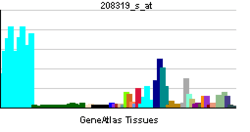RBM3
Putative RNA-binding protein 3 is a protein that in humans is encoded by the RBM3 gene.[3][4]
This gene is a member of the glycine-rich RNA-binding protein family and encodes a protein with one RNA recognition motif (RRM) domain. Expression of this gene is induced by cold shock and low oxygen tension. A pseudogene exists on chromosome 1. Alternate transcriptional splice variants, encoding different isoforms, have been characterized.[4]
References
Further reading
- Danno S, Nishiyama H, Higashitsuji H, et al. (1997). "Increased transcript level of RBM3, a member of the glycine-rich RNA-binding protein family, in human cells in response to cold stress". Biochem. Biophys. Res. Commun. 236 (3): 804–7. doi:10.1006/bbrc.1997.7059. PMID 9245737.
- Strausberg RL, Feingold EA, Grouse LH, et al. (2003). "Generation and initial analysis of more than 15,000 full-length human and mouse cDNA sequences". Proc. Natl. Acad. Sci. U.S.A. 99 (26): 16899–903. doi:10.1073/pnas.242603899. PMC 139241
 . PMID 12477932.
. PMID 12477932.
- Chappell SA, Mauro VP (2003). "The internal ribosome entry site (IRES) contained within the RNA-binding motif protein 3 (Rbm3) mRNA is composed of functionally distinct elements". J. Biol. Chem. 278 (36): 33793–800. doi:10.1074/jbc.M303495200. PMID 12824175.
- Wellmann S, Bührer C, Moderegger E, et al. (2004). "Oxygen-regulated expression of the RNA-binding proteins RBM3 and CIRP by a HIF-1-independent mechanism". J. Cell. Sci. 117 (Pt 9): 1785–94. doi:10.1242/jcs.01026. PMID 15075239.
- Brill LM, Salomon AR, Ficarro SB, et al. (2004). "Robust phosphoproteomic profiling of tyrosine phosphorylation sites from human T cells using immobilized metal affinity chromatography and tandem mass spectrometry". Anal. Chem. 76 (10): 2763–72. doi:10.1021/ac035352d. PMID 15144186.
- Gerhard DS, Wagner L, Feingold EA, et al. (2004). "The Status, Quality, and Expansion of the NIH Full-Length cDNA Project: The Mammalian Gene Collection (MGC)". Genome Res. 14 (10B): 2121–7. doi:10.1101/gr.2596504. PMC 528928
 . PMID 15489334.
. PMID 15489334.
- Dellis S, Strickland KC, McCrary WJ, et al. (2005). "Protein interactions among the vaccinia virus late transcription factors". Virology. 329 (2): 328–36. doi:10.1016/j.virol.2004.08.017. PMID 15518812.
- Andersen JS, Lam YW, Leung AK, et al. (2005). "Nucleolar proteome dynamics". Nature. 433 (7021): 77–83. doi:10.1038/nature03207. PMID 15635413.
- Ross MT, Grafham DV, Coffey AJ, et al. (2005). "The DNA sequence of the human X chromosome". Nature. 434 (7031): 325–37. doi:10.1038/nature03440. PMC 2665286
 . PMID 15772651.
. PMID 15772651.
- Ong SE, Mittler G, Mann M (2005). "Identifying and quantifying in vivo methylation sites by heavy methyl SILAC". Nat. Methods. 1 (2): 119–26. doi:10.1038/nmeth715. PMID 15782174.
- Rual JF, Venkatesan K, Hao T, et al. (2005). "Towards a proteome-scale map of the human protein-protein interaction network". Nature. 437 (7062): 1173–8. doi:10.1038/nature04209. PMID 16189514.
- Martínez-Arribas F, Agudo D, Pollán M, et al. (2006). "Positive correlation between the expression of X-chromosome RBM genes (RBMX, RBM3, RBM10) and the proapoptotic Bax gene in human breast cancer". J. Cell. Biochem. 97 (6): 1275–82. doi:10.1002/jcb.20725. PMID 16552754.

 . PMID 12477932.
. PMID 12477932. . PMID 15489334.
. PMID 15489334. . PMID 15772651.
. PMID 15772651.